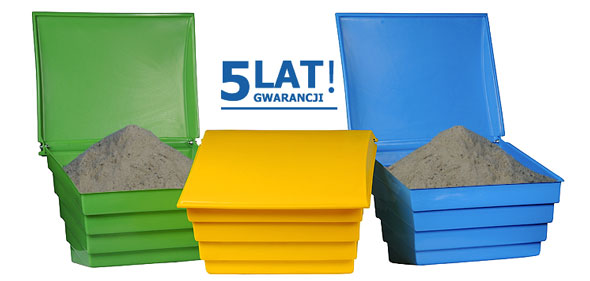- favorite 4 likes
- remove_red_eye 3264 views
- comment 0 comments

SELECTION OF CONTAINERS FOR SAND AND SALT
How to choose the right number and capacity of sand and salt containers?
Unfortunately, winter is not only a beautiful landscape, mountains, winter holidays, sledging or skiing, but also a time when you have to deal with everyday problems related to severe weather conditions. In winter, snow everywhere is a real bane for drivers and pedestrians, especially in cities. It is worth thinking about it before the first rainfall.

Property Owners' Responsibilities
The legal act that obliges the property owner to remove snow and ice from the pavement is the Act of September 13, 1996 on maintaining cleanliness and order in municipalities. The Act sets out the obligations of property owners, such as: snow removal and ice removal from the sidewalk along the property and the yard. Property owners are also responsible for removing icicles and snow piles from the roofs of buildings and farm buildings. If an accident occurs on a snowy or icy pavement, the owner will have to pay compensation, pension or compensation to the injured person. According to Art. 117 of the Code of Petty Offenses, anyone who fails to fulfill the obligation to maintain order within their property is subject to a fine of up to PLN 1,500 or a reprimand. The property owner chooses the measures he will use to remove black ice. In practice, sand, aggregate, magnesium chloride, calcium chloride and mixtures of chemical and non-chemical agents are most often used. These measures prevent the formation of icing and slippage, which occurs after remaining frozen, unremoved snow.
Types of sand and salt containers
There are many different types of sand and salt containers on the market today. A variety of patterns and original constructions make the containers fit perfectly with any place. When choosing an appropriate container, you should also pay attention that the loose materials stored in them do not lose their utility value. Materials of this type, soaked with moisture, clump and become very heavy, which makes them lose their properties. You can choose from containers made of polyethylene, glass laminate or sheet metal. It is important that the material from which the containers are made is resistant to weather conditions (moisture, low temperatures, UV radiation) and to corrosion. Various box sizes are available depending on the requirements of the containers. Top-class polyethylene containers are made of high-quality granules, which makes them durable, resistant to cracks or impacts. The durable structure protects the containers against mechanical damage. The material from which the boxes are made is highly resistant to acids, bases, salts and most chemicals. With the use of appropriate dyes and modern technology, the containers do not change color when exposed to sunlight. The wide range of colors of the containers allows you to choose the right color that will perfectly match the facade of the building or harmonize with the color and style of the surroundings. Depending on the needs, the containers can be equipped with system locks or padlocks. Large models of sand and salt boxes, thanks to a specially profiled base, are ideal for transport with a forklift. In order to facilitate the use of the containers, they can be equipped with an opening for easy removal of sand with a shovel. Depending on the needs, it is possible to make a company logo or an inscription on the containers. At the end of the winter period, the crates can be stacked and therefore take up little space.
Selection of the size of the sand and salt container
The capacity of the boxes for sand and salt should be matched to the surface of pavements or squares intended for sprinkling. Assuming that 1 kilogram of sand (volume about 0.7 liters) can fit on one shovel, we will sprinkle about 2 m2 of the surface. That is, for proper sprinkling of a 100 m2 pavement, approximately 35 liters of sand should be used. In this case, a 70-liter storage container is enough to sprinkle such a pavement twice. Depending on the frequency of snowfall, a sufficiently large supply of anti-slip material should be worn. If we are sprinkling sand or salt on a large area, e.g. a parking lot, it is worth buying two or three smaller containers. More containers, which will be placed in different places, will facilitate and improve the work of sprinkling the icy surface.

Comments (0)